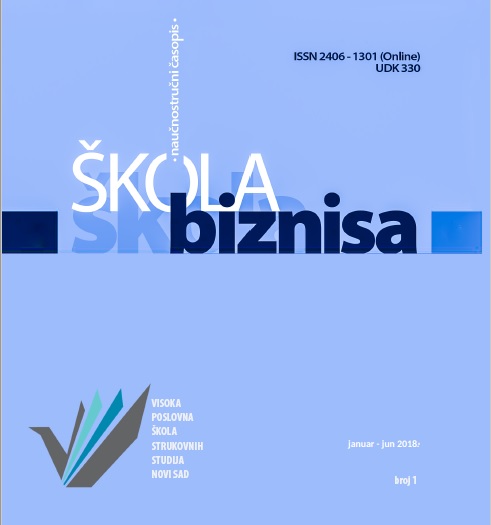THE ROLE OF MARKET VALUATION MODELS IN INVESTMENT DECISION-MAKING PROCESSES
Abstract
The ground floor for deciding on the purchase or sale of shares or entire enterprises, recapitalization and other investment transactions are obtained in two basic understandings of value, the market price and the intrinsic value of companies. The price of shares or companies as a whole is the result of the supply and demand relationship and as such can be determined if there is an active market. On perfectly efficient markets, stock prices should match its intrinsic value. The intrinsic value is determined in the valuation process that requires the application of the selected valuation models. Market valuation models, on the one hand, rely on traditional models of valuation, while on the other hand they involve in valuation process information and tendencies from the market. The aim of this paper is to examine the role of these models in investment decision-making processes.
References
Ali A., & Hwang, L.S. (2000). Country-Specific Factors Related to Financial Reporting and the Value Relevance of Accounting Data. Journal of Accounting Research, 38(1), 1-21.
Copeland, T., Weston, J.F., & Shastri, K., (2004). Financial Theory and Corporate Policy, 4th edition. Boston, SAD: Addison-Wesley.
Damodaran, A. (2004). Investment Fables. Exposing the Myths of „Can’t Miss“ Investment Strategies. New York: Prentice Hall.
Fama, E.F. (1970). Efficient Capital Markets: A Review of Theory and Empirical Work. Journal of Finance, 25(2), 383-417.
Fernandes, P. (2002). Valuation Using Multiples. How Do Analysts Reach Their Conclusions?. IESE Business School Research Papers, 1-13.
Jones, C.P. (2008). The Intelligent Portfolio. Practical Wisdom on Personal Investing from Financial Engines. Hoboken: John Wiley & Sons.
Kaćanski, S., Tomašević, S., & Vlaović Begović S. (2014). Periodično finansijsko izveštavanje u funkciji poslovnog odlučivanja. Škola biznisa, 1/2014, 52-68.
Kronholm, M. (2013). Valuation of unlisted direct investment equity and the impact on finnish international investment position. (Master thesis). Aalto University, School of business. Dostupno na: http://epub.lib.aalto.fi/fi/ethesis/pdf/13492/hse_ethesis_13492.pdf dana 09.03.2017.
Nel, W. S., & Le Roux, N.J. (2015). An Optimal Peer Group Selection Strategy for Multiples-Based Modeling in the South African Equity Market. Journal of Economics and Behavioral Studies, 7(3), 30.
Salmanov, O., Babina, N., Bashirova, S., & Samoshkina, M. (2015). Multiples for Valuation Estimates of Companies in the Technology Sector of Emerging Markets. Asian Social Science, 11(8).
Saković, D. (2018). Analitički pokazatelji homogene grupe entiteta kao determinanta modela tržišnih multiplikatora za vrednovanje preduzeća. (Doktorska disertacija). Novi Sad, Republika Srbija: Ekonomski fakultet u Subotici, Univerzitet u Novom Sadu.
Schreiner, A. (2007). Equity Valuation Using Multiples: An Empirical Investigation, (Doctoral dissertation). Wiesbaden: Univerzitet St. Gallen.
Spremann, K. (2002). Finanzanalyse und Unternehmensbewertung. Munich, Germany: Oldenbourg.
Spremann, K. (2006). Portfoliomanagement, 3rd edition. Munich, Germany: Oldenbourg.
Stankov, B., Roganović, M., & Marjanski Lazić, S. (2015). Perspektiva i potrebe investitora u procesu izrade biznis planova. Škola biznisa, 2/2015, 80-96.
Tasker, S.C. (1998). Industry-preferred Multiples in Acquisition Valuation. Working paper, Cornell University.
- Authors retain copyright and grant the journal right of first publication with the work simultaneously licensed under a Creative Commons Attribution License that allows others to share the work with an acknowledgement of the work's authorship and initial publication in this journal.
- Authors are able to enter into separate, additional contractual arrangements for the non-exclusive distribution of the journal's published version of the work (e.g., post it to an institutional repository or publish it in a book), with an acknowledgement of its initial publication in this journal.
- Authors are permitted and encouraged to post their work online (e.g., in institutional repositories or on their website) prior to and during the submission process, as it can lead to productive exchanges, as well as earlier and greater citation of published work (See The Effect of Open Access).

